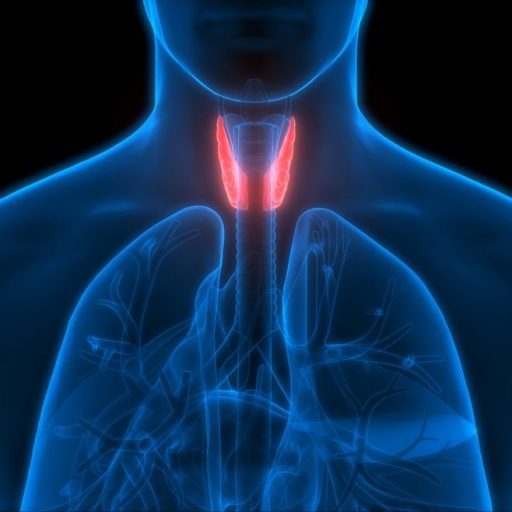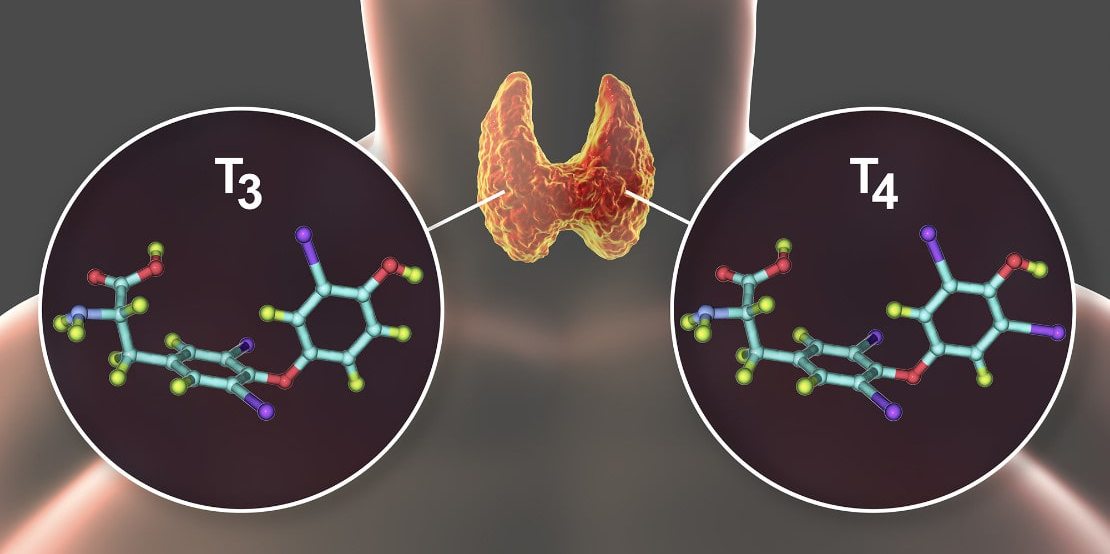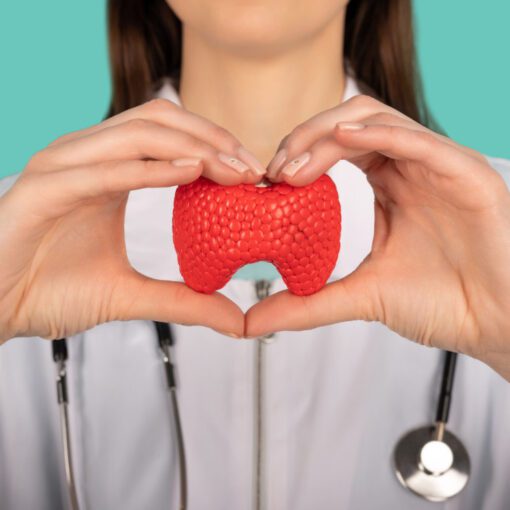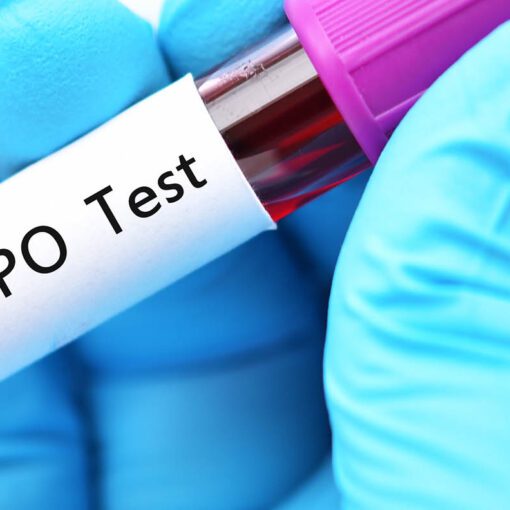The primary test for hypothyroidism is FT4 – free T4. Many people do not question the outcome of thyroid function tests. Or for that matter you can ask for a copy, which they are entitled to, they are YOUR tests. Patients cannot understand why these tests do not work. No one tells them that because the T4 level in their blood is within the range, (set decades ago) does not mean that they will be well. Thyroid needs other hormones to make it work. Many people are toxic to Thyroxine and feel very ill while taking it.
Thyroxine has additives, maize and e-numbers added in some of the cheaper brands. Many doctors and endocrinologists seem to think Thyroxine is a supplement to the person’s own thyroid. This simply is not true because the brain says that it does not need to make TSH, (thyroid stimulating hormone), any more and shuts this hormone down.
Low levels of Thyroxine are dangerous, and should always be questioned. (See Blood Tests Information sheets for more details of ranges, tests etc.) The FT3, (free thyroid 3 circulating in the blood unbound), test is rarely done. Many people cannot convert T4 into T3 because of low liver function.
Eating high carbohydrates and low oils can cause this. HRT and alcohol, also causes this downturn. Many women become hypothyroid when taking pharmaceutical HRT, which also affects T4 to T3 conversion in the liver.
G.P.’s rarely prescribe T3 because it is more expensive, another name for T3 is Cytomel or Cynomel.
Suggested Thyroid Function Tests:
- Free T4 suggested appropriated level for optimum wellness in a range of 9-23 is 17 (half way)
- Free T3
- TSH (this will be reduced if you are taking thyroid supplements to around 0.03)
TSG – INFORMATION SHEET – BLOOD TESTS
The thyroid gland makes two primary hormones T4 and T3 – it also makes calcitonin which regulates calcium in the body in conjunction with the parathyroids. More T4 is usually made than T3. T3 is five times more concentrated than T4. The two functions of these hormones are different. T4 has four iodine atoms – like ears – and is responsible for cell regeneration and temperature control. T3 is converted from T4 in the liver and its primary function is energy. T4 is bound to a thyroid protein initially which is called TT4 (total T4).
Oestrogen is also at times bound to T4 and a TT4 blood test includes this binding. For example women on HRT – oestrogen – will have elevated blood results, this is because under the microscope the thyroid hormone sits on the back of oestrogen and looks like crystal. It is true that the thyroid needs a LITTLE oestrogen to carry it around the body, however too much drowns it and stops it from working because it blocks T4 – T3 conversion in the liver. When the hormones T4 and T3 are unbound to proteins they are free and the blood test for this is FT4 and FT3. Free means that the hormone is available for cell use.
Pituitary gland
The pituitary gland within the center of the brain produces TSH which is thyroid stimulating hormone. When an outside delivery of T4 is introduced (like Thyroxine), TSH reduces to below 0.0 level e.g. your TSH result if you take Thyroxine may be 0.03. The range is 0.5 – 6.0, the average being 2.9. This test is commonly done by biochemists in the lab. as a prime indicator of PRIMARY hypothyroidism – i.e. when the thyroid is out of control the TSH is high because the pituitary gland is trying to stimulate the thyroid into action. Biochemists are now saying that is TSH is within the range there is no need to do any further testing and that your thyroid is working alright.
A quote from Medicine International reads “The TSH levels are normal in approximately 50% of patients with secondary hypothyroidism but TT4 and FT4 are usually low”.
Another quote on TSH this time from the Department of Health, London reads “If there is a change greater than 0.8 that is significant”. The problem with this statement is that most of us do not have a baseline test when we are well, so no one knows what the rise or fall is.
Reference ranges are supplied to give guidance to our doctors and have been designed by a 95% population sample in the 1950’s when blood tests were first introduced. One problem with this is that thanks to oil we now live in an oestrogen dominated world, where our food is packaged in plastic, we burn oil as fuel and live in a highly polluted world. Oestrogen dominance stops the thyroid from working properly.
The second blood test that should be done is the FT4 one. The range is 10 – 24, or 9 – 23. The average is 17. A double blind trial at Birmingham University in 1997 concluded the following:
- Those with hypothyroid symptoms fell in the 10 – 14 range
- Those diagnosed with M.E. fell into the 14 – 16 range
- Those normal fell into the 17 – 24 range.
TT4 (total T4) is often done by outdated labs. Many common medicines affect this test and TT4 is futile in many cases.
Reasons for laboratory testing are:
- to confirm the clinical diagnosis
- to monitor patients who have been treated
- to select removal of the thyroid gland
TSH testing may be affected by steroidal drugs. Or by a tumour of the pituitary gland.
The most common diagnosis is one of elevated TSH in conjunction with low T4.
The thyroid gland also makes thyroid binding proteins. Aspirin destroys this simple action. Free thyroid levels represent less than 1% of the total number of thyroid hormones in the bloodstream.
The FT4 test in theory should by total T4 multiplied by T3 resin uptake and should be proportional to free T4.
FT3 is very rarely done. The conversion of T4 to T3 in the liver by growth hormone is largely ignored by the medical profession.
Eighty percent of people who contact the group are diagnosed hypothyroid but still unwell because they are monitored by blood testing. The amount of Thyroxine in the blood stream does not equate to having a level high enough to make you feel well. Indeed some people are toxic to Thyroxine and need Tertroxin T3 for their energy.
The TT4 test range is 50 – 160, your result may be 90. mine was and I felt terrible. But was it really 90 or was it lower because I was on pharmaceutical HRT?
Under the Patients Charter you are entitled to see or have a photocopy of your thyroid function test. If anyone tells you it is normal get a copy and we will interpret it for you.
Some things to NEVER DO before a blood test: drink caffeine, alcohol, or have any stimulant. Chocolate can alter it. Make sure that you do not wash your hair because alum in shampoos affects blood tests. Never be tested in the morning because your hormones are at their highest then. Cortisol interacts with thyroid hormones and it declines as the day progresses. You can have a blood test and have another five minutes later and there can be 10 points difference between them.
Finally the report done by the Audit Commission in December 2020 states that “50% of laboratories provide false test results. One doctor sent two samples out of the same arm and needle with two different names on to test the lab. They both came back different.
WERE YOU EVER TESTED WHEN YOU WERE “NORMAL”?
Reference Values for Blood (B), Plasma (P), and Serum (S)
NORMAL ADULT RANGE
| Test | Conventional Units | SI Units |
|---|---|---|
| Blood, Acetoacetate plus acetone (B) | Negative | Negative |
| Blood, Aldolase (S) | 1.0-8.0 u./L | 16.6-135 nkat/L* |
| Blood, Aminotransferase (S) | ||
| – Alanine (ALT, SGPT) | 5-30 u./L | 83-500 nkat/L* |
| – Aspartate (AST, SGOT) | 5-25 u./L | 83-415 nkat/L* |
| Blood, Ammonia (B) | 11-35 mmol/L | 11-35 m mol/L |
| Blood, Amylase (S) | 60-160 u./dL | 111-296 u./L |
| Blood, Ascorbic acid (B) | 0.4-1.5 mg/dL | 23-85 mmol/L |
| Blood, Bilirubin (S) | ||
| – Direct (Conjugated) | 0.1-0.4 mg/dL | 1.7-6.8 mmol/L |
| – Total | 0.3-1.1 mg/dL | 5.1-19.0 mmol/L |
| Blood volume | 8.5-9.0% of body weight (kg) | 80-85 mL/kg |
| Blood, Calcium (S) | ||
| – Ionized | 2.1-2.6 mEq/L | 1.05-1.30 mmol/L |
| 4.25-5.25 mg/dL | ||
| – Total | 4.6-5.5 mEq/L | 2.3-2.75 mmol/L |
| 9.2-11.0 mg/dL | ||
| Blood, Carbamazepine (P) | 3-12 mg/mL | 12.75-51.0 mmol/L |
| Blood, CO2 content (S) | 24-30 mEq/L | 24-30 mmol/L |
| Blood, CO (B) | <5% of total Hb | <5% of total Hb |
| Blood, Carotenoids (S) | 0.5-3.0 mg/mL | 0.9-5.6 mmol/L |
| Blood, Ceruloplasmin (S) | 27-37 mg/dL | 1.8-2.5 mmol/L |
| Blood, Chloride (S) | 96-106 mEq/L | 96-106 mmol/L |
| Blood, Cholesterol (S) | 120-220 mg/dL | 3.1-5.68 mmol/L |
| Blood, CK (S) | ||
| – Female | 10-70 u./L | 166-1167 nkat/L* |
| – Male | 25-90 u./L | 416-1500 nkat/L* |
| Blood, CK isoenzymes (S) | 5% MB or less | |
| Blood, Copper (S) | 70-155 mg/dL | 11-24 mmol/L |
| Blood, Creatinine (S) | <1,5 mg/dL | <133 mmol/L |
| Blood, Digoxin (S) | ||
| – Therapeutic | 0,8-2,0 ng/mL | 1,0-2,6 nmol/L |
| – Toxic | >2,5 ng/mL | >3,2 nmol/L |
| Blood, Ethanol (B) | Negative | |
| Blood, Glucose, fasting (P) | 75-105 mg/dL | 4,2-5,8 mmol/L |
| Blood, Iron (S) | ||
| – Total | 50-150 mg/dL | 9-27 mmol/L |
| – Binding capacity | 250-410 mg/dL | 45-73 mmol/L |
| Blood, Lactate (B) | ||
| – Venous | 4,5-20 mg/dL | 0,5-2,2 mmol/L |
| – Arterial | 4,5-14,4 mg/dL | 0,5-1,6 mmol/L |
| Blood, Lactic dehydrogenase (S) | 50-115 u./L | 833-1917 nkat/L* |
| Blood, Lead (B) | 0-50 mg/dL | 0-2,4 mmol/L |
| Blood, Lipase (S) | 0-1,5 u. (Cherry-Crandall) | 0-1,5 u. (Cherry-Crandall) |
| Blood, Lithium (S) | ||
| – Therapeutic | 0,5-1,4 mEq/L | 0,5-1,4 mmol/L |
| – Toxic | 2,0 mEq/L | >2.0 mmol/L |
| Blood, Magnesium (S) | 1.3-2,1 mEq/L | 0,7-1,1 mmol/L |
| 1,8-3,0 mg/dL | ||
| Blood, 5′ – Nucleotidase (S) | 1-12 u./L | 16,6-200 nkat/L* |
| Blood, Osmolality (S) | 280-295 mOsm/kg | 280-295 mmol/kg |
| – serum water | serum water | |
| Blood, Oxygen saturation (B) | ||
| – Arterial | 96-100% | 0,96-1.00 |
| Blood, Pco2 (B) | 35-45 mm Hg | 4,7-6,0 kPa |
| Blood, pH (B) | 7,35-7,45 | 7,35-7,45 |
| Blood, Po2 (B) | 75-100 mm Hg | 10,0-13,3 kPa |
| Blood, Phenobarbital (S) | ||
| – Therapeutic | 15-50 mg/mL | 65-215 mmol/L |
| – Toxic | >50 mg/mL | >215 mmol/L |
| Blood, Phenytoin (S) | ||
| – Therapeutic | 5-20 g/mL | 20-79 mol/L |
| – Toxic | >20 g/mL | >79 mol/L |
| Blood, Phosphatase, acid (S) | 0,2-1,8 IU/L | 3,3-30 nkat/L* |
| Blood, Phosphatase, alkaline (S) | 23-71 IU/L | 383-1185 nkat/L* |
| Blood, Phosphorus, inorganic (S) | 3-4,5 mg/dL | 1,0-1,5 mmol/L |
| 1-1,5 mEq/L | ||
| Blood, Potassium (S) | 3,5-5,0 mEq/L | 3,5-5,0 mmol/L |
| Blood, Primidone (S) | ||
| – Therapeutic | 5-12 mg/mL | 23-55 mmol/L |
| – Toxic | >15 mg/mL | >69 mmol/L |
| Blood, Procainamide (S) | ||
| – Therapeutic | 4-10 mg/mL | 17-42 mmol/L |
| – Toxic | >16 mg/mL | >68 mmol/L |
| Blood, Protein (S) | ||
| – Total | 6,0-8,0 gm/dL | 60-80 gm/L |
| – Albumin | 3,5-5,5 gm/dL | 35-55 gm/L |
| – Globulin | 2,0-3,5 gm/L | 20-35 gm/L |
| Blood, Electrophoresis | ||
| – Globulin | 0,1-0,4 gm/dL | 1-4 gm/L |
| – a1 | 0,4-1,1 gm/dL | 4-11 gm/L |
| – a2 | 0,5-1,6 gm/dL | 5-16 gm/L |
| – b | 0,5-1,4 gm/dL | 5-14 gm/L |
| – g | ||
| Blood, Pyruvic acid (B) | 0,3-0,9 mg/dL | 0,03-0,10 mmol/L |
| Blood, Quinidine (S) | ||
| – Therapeutic | 1,2-4,0 mg/mL | 3,7-12,3 mmol/L |
| – Toxic | >10 mg/mL | >30 mmol/L |
| Blood, Salicylate (P) | ||
| – Analgesic | 20-100 mg/mL | 145-724 mmol/L |
| – Anti-inflammatory | 150-300 mg/mL | 1086-2172 mmol/L |
| – Toxic | >300 mg/mL | >2172 mmol/L |
| Blood, Sodium (S) | 135-145 mEq/L | 135-145 mmol/L |
| Blood, Sulfate (S) | 2,9-3,5 mg/dL | 0,3-0,36 mmol/L |
| Blood, Triglycerides (S) | 35-160 mg/dL | 0,40-1,81 mmol/L |
| Blood, Urea nitrogen (S) | 8-23 mg/dL | 2,9-8,2 mmol/L |
| Blood, Uric acid (S) | 3-7 mg/dL | 0,18-0,42 mmol/L |
| Blood, Vitamin A (S) | 20-60 mg/dL | 0,7-2,1 mmol/L |
| Blood, Vitamin D derivatives (S) | ||
| – 1,25 – dihydroxy | 20-45 pg/mL | 48-108 pmol/L |
| – 25 – hydroxy | 25-40 ng/mL | 62,5-100 nmol/L |
REFERENCE VALUES FOR URINE
NORMAL ADULT RANGE
| Test | Conventional Units | SI Units |
|---|---|---|
| Urine, Acetone plus acetoacetate | Negative | Negative |
| Urine, Amylase | 1-17 u./h | 1-17 u./h |
| Urine, Calcium | <300 mg./day | <7,5 mmol/day |
| Urine, Catecholamines | ||
| – Epinephrine | <10 mg/day | 55 nmol/day |
| – Norepinephrine | <100 mg/day | |
| Urine, Chorionic gonadotropin | Negative | Negative |
| Urine, Copper | 0-50 mg/day | 0-0,8 mmol/day |
| Urine, Coproporphyrin | 30-250 mg/day | 46-380 nmol/day |
| Urine, Creatine | ||
| – Females | <100 mg/day | <0,76 mmol/day |
| – Males | <40 mg/day | <0,30 mmol/day |
| Urine, Creatinine | 14-26 mg/kg/day | 0,12-0,23 mmol/kg/day |
| Urine, Cystine or cysteine | Negative | Negative |
| Urine, Hemoglobin and myoglobin | Negative | Negative |
| Urine, 17-Hydroxycorticosteroids | 2-9 mg/day | 5,5-25 mmol/day |
| Urine, 5-Hydroxyindoleacetic acid | 2-9 mg/day | 10-47 mmol/day |
| Urine, 17-Ketosteroids | 4-18 mg/day | 14-62 mmol/day |
| Urine, Lead | <120 mg/day | <0,39 mmol/L |
| Urine, Phosphorus, inorganic | 0,4-1,3 gm/day | 13-42 mmol/day |
| Urine, Porphobilinogen | Negative | Negative |
| Urine, Protein | <150 mg/day | <150 mg/day |
| Urine, Sugar, quantitative glucose | Negative | Negative |
| Urine, Urobilinogen | 0,5-4,0 EU/day | 0,5-4,0 EU/day |
| Urine, Uroporphyrin | <50 mg/day | <60 nmol/day |
| Urine, Vanillylmandelic acid (VMA) | 1-9 mg/day | 5-45 mmol/day |
Finally it is important for you to check your test, look at it, discuss it and make sure that it is repeated 2 weeks later.






